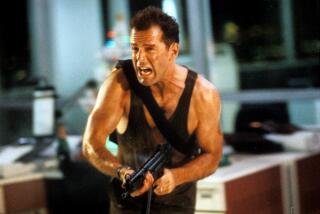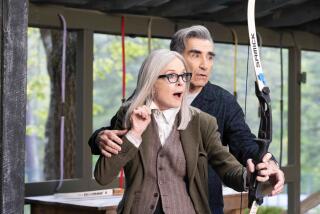TV REVIEW : Buster Keaton: Always a ‘Hard Act to Follow’
- Share via
In the comedian’s world of slap shoes and “gags,” Buster Keaton was silent film’s Pierrot, his grave, moon-pale face a beacon of purity. Keaton was the cat who walked alone. Too elegant to ever beg for audience pity, he won their unconditional admiration instead.
Tonight at 10, KCET Channel 28 shows the first two installments of “Buster Keaton: A Hard Act to Follow,” a three-part documentary series on Keaton’s life, a rueful and generally unfunny affair in which talent was overshadowed by alcoholism, and love--until he married Eleanor--invariably meant pain.
Made by David Gill and Kevin Brownlow, who together made the 13-part “Hollywood” and the invaluable and prize-winning “Unknown Chaplin,” and narrated by director Lindsay Anderson, this is a film whose grace, precision and honesty might meet even Buster’s impeccable standards. And, for Keatonophiles, it is packed with rare, behind-the-scenes footage showing, occasionally, just how he did the impossible.
The film makers’ jumping-off place is a rare, almost forgotten 1964 biographical interview in which Keaton describes his knockabout childhood as part of his parents’ traveling medicine show, and goes on to describe the inner workings of his films, both the two-reelers and such features as “Sherlock Jr.” and “The Navigator.”
Over the three programs, we watch Keaton balance, fly, catapult, teeter and even be screwed into the ground head first, all with the same measured, deadpan delicacy. “I learned the more serious I looked, the better laughs I got,” Keaton confides.
There is also footage of Keaton swept downstream in a raging torent, while his anguished cameramen, sticking to the master’s ironclad orders, cranks away helplessly. Program 2 has that exquisite moment in “Steamboat Bill Jr.’s” cyclone, where Keaton stands on the street as the front of a house crashes down, framing him precisely in its doorway. “It weighed about 1,000 pounds,” comments Dean Reisner, son of the film’s director, “and if he was six inches off his mark, Buster would have been driven into the ground like a little tent peg.”
It is the hallmark of Gill and Brownlow that they fill in all the details of such a scene. Only moments before, Keaton had had news that signaled the end of all creative control of his work--his boss, Joe Schenck, had sold his contract to MGM. And as the house falls over, his wife’s voice is heard saying, “He had reached a point where he didn’t care a lot.” Keaton’s posture assumes an extra measure of resignation as we watch the scene a last time.
The programs include interviews with Keaton contemporaries including actor and friend William Collier Jr.; the redoubtable Sam Marx, former head of the MGM story department; silent star Viola Dana, and the splendid Eleanor Keaton, his widow, among others.
Best of all, though, is time spent watching the undistractable Keaton himself: “Plain bones, Egyptian eyes, tight skin, nose carved of shale,” as Walter Kerr pegged him. And, as we learn for ourselves, a man of unutterable sweetness.
More to Read
The complete guide to home viewing
Get Screen Gab for everything about the TV shows and streaming movies everyone’s talking about.
You may occasionally receive promotional content from the Los Angeles Times.






